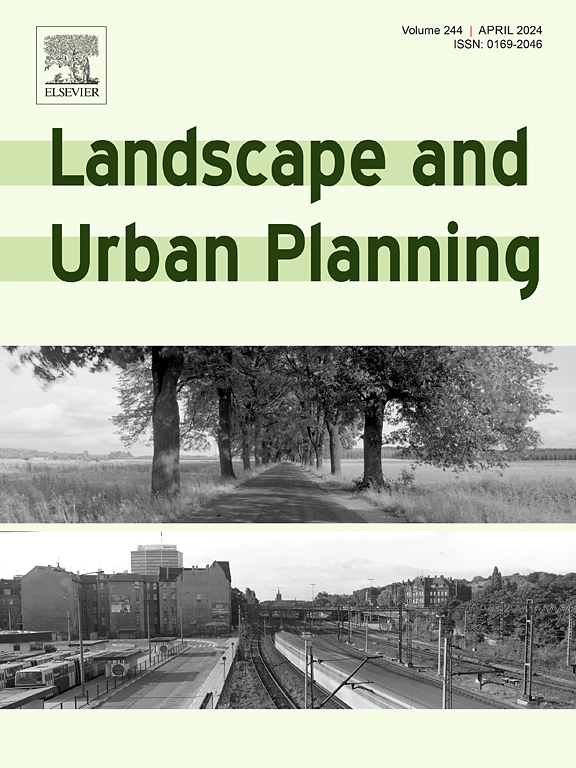基于CEP-KASS框架的城市街道视觉色彩环境感知
IF 9.2
1区 环境科学与生态学
Q1 ECOLOGY
引用次数: 0
摘要
城市街道的色彩在塑造城市形象和影响人们的情感认知方面起着至关重要的作用。然而,人们很少深入探讨街道色彩环境与居民感知之间的关系,现有研究也主要采用定性方法。为了准确有效地评估街道景观色彩与居民情感认知之间的联系和影响,本文介绍了一种基于多源数据的定量研究框架:带有 K-Means、SegNet 和 SVM(CEP-KASS)的色彩情感认知框架。该框架创新性地将居民感知与城市色彩特征相结合,为城市色彩规划提供了新的视角和方向。本研究以天津市中心城区为研究对象,采用机器学习模型预测人类对百度街景图像(BSVI)的感知,并从这些图像中提取色彩特征。然后分析了街道景观色彩与人类情感感知之间的关系。研究结果表明,在色彩感知方面,蓝色和绿色与繁荣和活力的情绪呈正相关,而红色和黄色与安全感呈负相关。在色彩属性方面,明亮的色彩会提高城市街道空间的无聊感得分,而过低的亮度则会降低这些区域对居民的吸引力。亮度与活力感知得分成反比,反向调节亮度可以增强城市户外空间的活力感知。本研究的主要贡献在于从色彩心理学的角度分析了街道色彩与人类感知之间的关系。此外,CEP-KASS 框架有助于对色彩和感知进行全面测量和分析,可推广到其他城市的研究中。研究成果为规划者提供了宝贵的见解,使他们能够在决策中考虑色彩变化的影响,从而增强居民的空间感知和情感体验。本文章由计算机程序翻译,如有差异,请以英文原文为准。

Perception of urban street visual color environment based on the CEP-KASS framework
The colors of urban streets play a vital role in shaping the city's image and influencing people's emotional perceptions. However, the relationship between street color environments and residents' perceptions has rarely been explored in depth, and existing studies predominantly adopt qualitative approaches. To accurately and effectively assess the connection and impact between street landscape colors and residents' emotional perceptions, this paper introduces a quantitative research framework based on multi-source data: the Color Emotion Perception framework with K-Means, SegNet, and SVM (CEP-KASS). This framework innovatively integrates residents' perceptions with urban color characteristics, offering a new perspective and direction for urban color planning. This study focuses on the central districts of Tianjin, employing machine learning models to predict human perception of Baidu Street View Images (BSVI) and to extract color characteristics from these images. An analysis is then conducted on the relationship between street landscape colors and human emotional perceptions. The findings indicate that, in terms of color perception, the prevalence of blue and green is positively correlated with emotions of prosperity and vitality, while the prevalence of red and yellow is negatively correlated with feelings of safety. Regarding color attributes, bright colors lead to higher boredom perception scores in urban street spaces, while excessively low brightness reduces the attractiveness of these areas to residents. Brightness is inversely related to vitality perception scores, and modulating brightness inversely can enhance the vitality perception in urban outdoor spaces. The main contribution of this study lies in its analysis of the relationship between street colors and human perception from the perspective of color psychology. Additionally, the CEP-KASS framework facilitates comprehensive measurement and analysis of color and perception, which can be extended to research in other cities. The research findings provide valuable insights for planners, allowing them to consider the impact of color changes in decision-making to enhance residents' spatial perception and emotional experience.
求助全文
通过发布文献求助,成功后即可免费获取论文全文。
去求助
来源期刊

Landscape and Urban Planning
环境科学-生态学
CiteScore
15.20
自引率
6.60%
发文量
232
审稿时长
6 months
期刊介绍:
Landscape and Urban Planning is an international journal that aims to enhance our understanding of landscapes and promote sustainable solutions for landscape change. The journal focuses on landscapes as complex social-ecological systems that encompass various spatial and temporal dimensions. These landscapes possess aesthetic, natural, and cultural qualities that are valued by individuals in different ways, leading to actions that alter the landscape. With increasing urbanization and the need for ecological and cultural sensitivity at various scales, a multidisciplinary approach is necessary to comprehend and align social and ecological values for landscape sustainability. The journal believes that combining landscape science with planning and design can yield positive outcomes for both people and nature.
 求助内容:
求助内容: 应助结果提醒方式:
应助结果提醒方式:


